Easy ITR Filing Process: 10 Steps to File Your ITR Online for FY 2023-24 (AY 2024-25)
Mitali Dhoke
Jun 27, 2024 / Reading Time: Approx. 10 mins
Listen to Easy ITR Filing Process: 10 Steps to File Your ITR Online for FY 2023-24 (AY 2024-25)
00:00
00:00
An Income Tax Return (ITR) is a document that you file with the Indian tax department to report your income, deductions, and taxes paid for a particular financial year. The Income Tax Act 1961 makes it mandatory for a taxpayer to file an income tax return under various scenarios. In addition to this, filing an ITR is also a legal requirement if your total income exceeds the basic exemption limit or if you have certain types of income, such as capital gains or foreign income.
We’ll soon enter into July, which is a crucial month for income tax assessees in India, owing to several tax-related activities and deadlines that coincide during this time. The tax-filing season is upon us, and many taxpayers are now gearing up to file their tax returns for the financial year ending 2023-24.
In every financial year, July 31st is traditionally marked as the deadline for filing Income Tax Returns (ITR) for individual taxpayers and non-audit entities. You have a few days left to file an Income Tax Return (ITR) for your earnings in the Financial Year (FY) 2023-24.
[Read: 7 Tax Planning Checks to Carry Out Before You File ITR For FY 2023-24]
For the Financial Year (FY) 2023-24 and Assessment Year (AY) 2024-25, the ITR needs to be filed on or before July 31st, 2024, unless extended. If this date is missed, a belated ITR can still be filed until December 31st, 2024, with a late filing penalty of Rs 1,000/-.
However, if the total income is more than Rs 5,00,000, then the penalty farthest will be expanded to Rs 5,000/-. The ITR currently being filed pertains to earnings during the FY 2023-24, spanning from April 01, 2023, to March 31, 2024.
A few changes have been made to the ITR forms for the FY 2023-24 (as compared to last year), which taxpayers should know before starting to file. Staying informed of these changes is crucial to ensure accurate ITR filing, as well as to maximise the tax benefits and deductions available.
Filing your ITR with incorrect or outdated information also increases the chances of errors. Though there are no major changes in the ITR forms this year, certain small changes have been made. This includes:
-
Reporting of income from Virtual Digital Assets (VDAs) like crypto, NFT, etc. in the ITR form
-
Submit Form 10-IE to opt out of New Tax Regime
-
Declare details of ARN (Donation Reference Number) to claim 80G deduction
-
Reporting of turnover from intraday trading
-
Disclosure of income on which Section 89A relief claimed
Keeping track of changes helps you avoid errors and ensures that you fulfil your tax obligations and your ITR is filed accurately.
The Income Tax Department provides the facility for electronic filing (e-filing) of an income tax return. With online ITR filing, it is convenient for taxpayers to file returns from the confines of their homes/offices. But, before moving towards the steps involved in the e-filing of an Income Tax Return, a taxpayer needs to calculate their total income for the financial year 2023-24 and beware of the ITR Form option based on their suitability.
Which ITR Form to file for FY 2023-24?
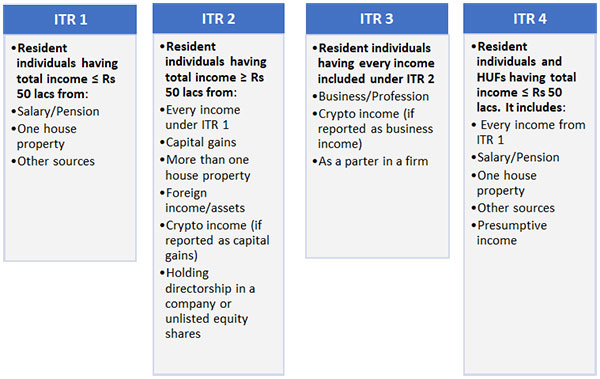
Going ahead, Form -16, which the employers provide, can help you determine your total income, as well as how much taxes have been deducted at the source. If you have other sources of income like income from house rent or capital gains, you must then calculate it before setting your hands on filing IT Returns.
Here's a few simple steps to follow in order to perform the e-filing of ITR for FY 2023-24:
Step #1 - Go to the Income Tax e-Filing portal, https://www.incometax.gov.in/iec/foportal/ and register using the details of your Aadhaar Card and Permanent Account Number (PAN); it will also serve as the user ID. Ensure your bank accounts are linked to your PAN, Aadhaar number, and mobile number.
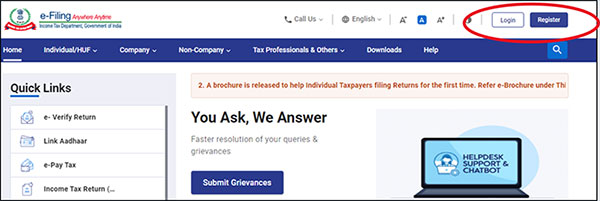
If you have already registered on the portal, log in to the e-Filing portal by entering your user ID (PAN), Password, and Captcha code, and click 'Login'.
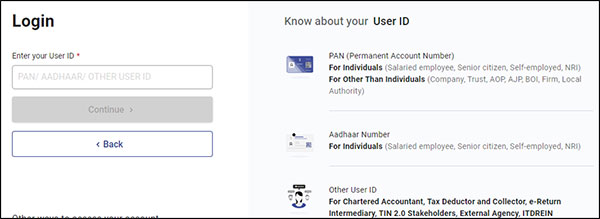
Step #2 - Click on the menu tab and choose E-File > Income Tax Returns > File Income Tax Returns.
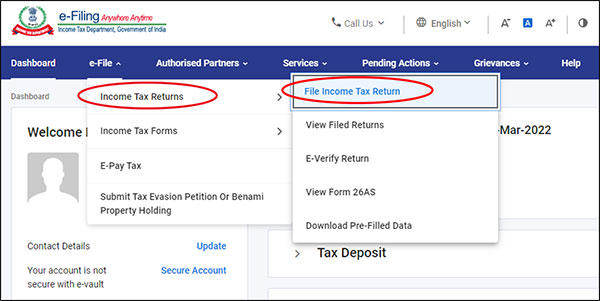
Step #3 - If you want to file IT Returns for the Financial Year 2023-24, you must choose Assessment Year (AY) 2023-24. Under the mode of filing, choose ‘Online’ and then click on ‘Continue’.
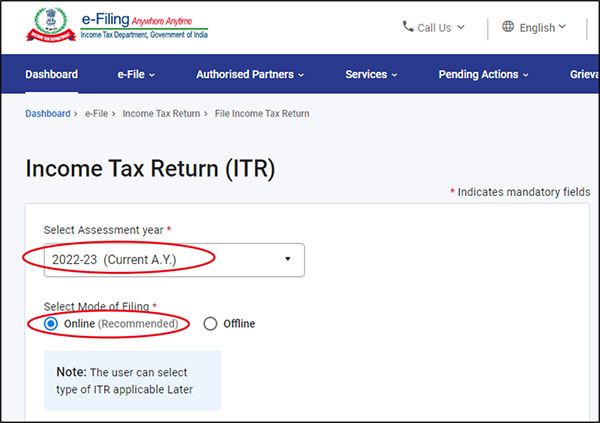
Step #4 - Choose whether you wish to file your Income Tax Return as an individual, Hindu Undivided Family (HUF), or others. Choose the option 'individual'.
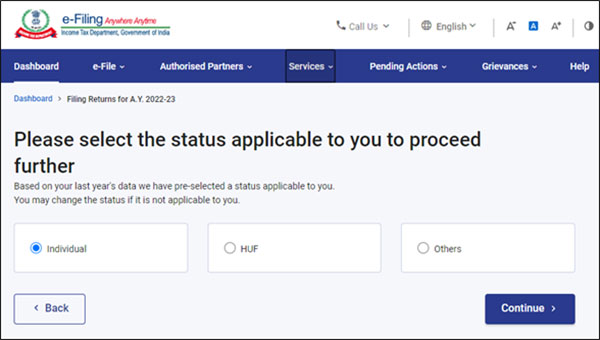
Step #5 - Choose the Income Tax Return (ITR) you wish to file. For example, ITR 2 can be filed by individuals and HUFs who don't have income from business or profession. Similarly, in the case of salaried individuals, they can choose the option ITR1 or ITR4. Here you will have to click 'Proceed with ITR1' (it is one of the simpler forms and caters to a large number of individual taxpayers).
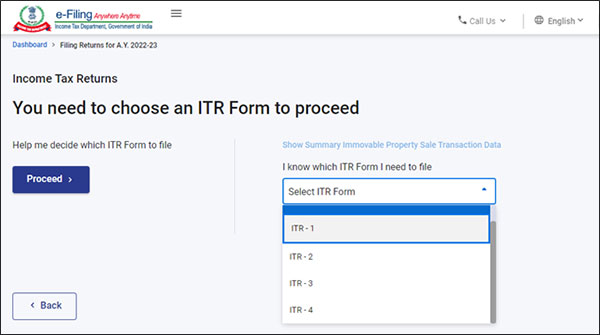
Step #6 - The next step will ask you the reason for filing your returns above the basic exempted limit or because of the seventh provision under Section 139(1). Make sure you choose the right option.
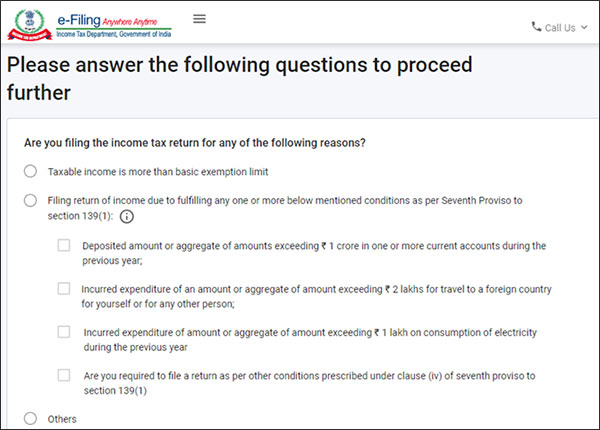
Step #7 - Now, you will move on to the most important segment of IT Return filing. On this page, you will find five tabs. You need to validate all those pieces of data and information one by one. The tabs are titled as Personal Information, Gross Total Income, Total Tax Deductions, Total Tax Paid, and Total Tax Liability. Read the Instructions carefully and Fill out all the applicable and mandatory fields of the Online ITR Form.
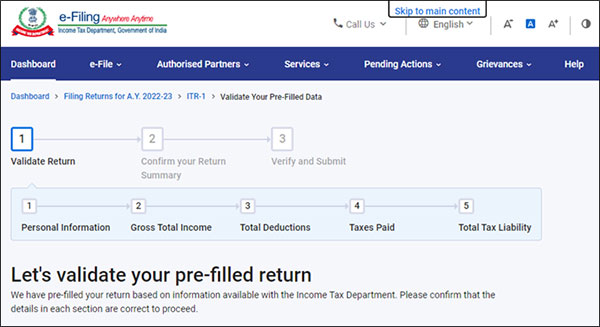
-
Personal Information - Check your Personal Details like PAN, Date of Birth, Mobile number, and Email address. Select your nature of employment as appropriate in your case. You also need to verify and update your bank details - Bank name and branch, Account number, and IFSC code.
-
Gross Total Income - You need to select the applicable exemptions in your case. Here you will find that the required details have been captured by the employer in Form 16. You can 'skip' this process and then click on 'Continue'.
-
Income From Other Sources - Depending on whatever is applicable in your case, you need to input details for fields, including dividend income, rental receipts from house property, interest income from bank deposits, and others.
-
Total Deductions - Fill in all the fields applicable in your case in order to claim tax deductions under Sections like 80C, 80D, and 80CCD. If these details have been given in Form 16, you will find that these fields are pre-filled, and you only need to validate the details after checking them.
-
Tax Paid - In this Section, you will find that the details are pre-filled from the data given earlier in form 26AS with TDS, TCS, Advance Tax, and Self-Assessment Tax.
Your Total Tax Liability will be automatically computed by the system. In case there is a tax liability, you will be shown a summary of your tax computation based on the details provided by you. If there is tax liability payable based on the computation, you get the Pay Now and Pay Later options at the bottom of the page.
Step #8 : Once you update and confirm all the details in the IT Return filing form, you have to click on 'Proceed' button. The system will generate a tax summary showing you your tax liabilities. If any refunds are applicable in your case, the system will register a refund request to the linked bank account. If any dues are to be paid, the summary will let you know how much you need to pay.
Step #9 : After that, select your bank account. This is the bank account where you will receive the tax refund (if any).
Step #10 : Once you have completed the steps as mentioned above in the ITR filing, you will have to 'Preview' the returns and click on 'Submit'. After submitting, select the declaration checkbox and click Proceed to Validation.
Step #11: The final step is to verify your returns and send the ITR summary or a hard copy of your ITR to the Income Tax Department. The verification process is mandatory.
Taxpayers must choose an appropriate verification option from the three options provided. You can either choose to e-verify quickly or e-verify within 120 days from the date of filing or send a signed ITR-V through normal or speed post within 120 days from the date of filing. You can validate the tax return in electronic mode through Electronic Verification Code (EVC) through net banking or through Aadhaar OTP. Enter the OTP/EVC sent on the registered mobile number and upload the ITR file online.
In case you wish to do it physically or via offline mode, you can take a print of the IT return copy, sign it and send a copy to the CPC of the Income Tax Department within 120 days of filing the IT returns.
Thereafter, at last, the Income Tax Department will process your return and notify you about the same through an email or SMS on your registered mobile number.
To Summarise...
Filing Income Tax Return is no longer the hassle it used to be in the past. In fact, a large number of taxpayers who are aware of their taxable income, deduction claims, etc., submit their ITR online on their own without consulting a professional. If you have the necessary information and documents, you can also file your ITR by yourself.
Pre-filling of data that is already available with the tax authorities has been made possible by the tax department. In addition to pre-filling the basic information boxes on the ITR Form, this feature also provides information about income on which tax has been deducted at source, dividend income, bank interest, etc. This choice will reduce the amount of data entering required by taxpayers and make ITR filing convenient. However, as there may be discrepancies between the actual amount taxable and the amount reflected in the pre-filled ITR, taxpayers must cross-check the information with their records.
Join Now: PersonalFN is now on Telegram. Join FREE Today to get PersonalFN’s newsletter ‘Daily Wealth Letter’ and Exclusive Updates on Mutual Funds.
MITALI DHOKE is a Research Analyst at PersonalFN. She is an MBA (Finance) and a post-graduate in commerce (M. Com). She focuses primarily on covering articles around mutual funds including NFOs, financial planning and fixed-income products. Mitali holds an overall experience of 4 years in the financial services industry.
She also actively contributes towards content creation for PersonalFN’s social media platforms in the endeavour to educate investors and enhance their financial knowledge.
Disclaimer: Investment in securities market are subject to market risks, read all the related documents carefully before investing.
This article is for information purposes only and is not meant to influence your investment decisions. It should not be treated as a mutual fund recommendation or advice to make an investment decision in the above-mentioned schemes.